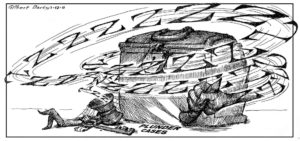The column “2M dads, husbands, BFs, classmates” (IAmGenM, 7/7/17) by Hyacinth Tagupa highlights the sickening subculture that has developed in the internet. In these online communities, suggestive pictures of women are passed around like trading cards, and the comment boxes are filled with lewd and abusive comments. I would like to point out the facts on how such a subculture has taken root and what we can do to stop this menace.
Firstly, I disagree with Ms Tagupa’s point that distribution and collection of porn materials are like usual internet fare. Whether revenge porn taken by amateurs or high-production studio videos featuring adults or minors, all pornography is demeaning. According to Dr. Gary Brooks, author of “The Centerfold Syndrome,” even widely accepted porn like Playboy exhibits objectification, or “an attitude in which women are objects rated by size, shape, and harmony of body parts.” So by exposing themselves to porn, men develop a skewed view of women, becoming unable to see them for who they really are.
The prevalence of pages like “Breezy Hokage” are symptomatic of how deeply entrenched porn is in our culture. In these circles, popular porn stars are viewed as “idols,” but those who subscribe to these pages rarely have an idea on what the toll is on these performers. Surveys say that almost 85 percent of porn performers have some form of STD and more than 79 percent have used or been forced to use illegal drugs.
Groups like these proliferate even under moderation and reporting on Facebook. That is why young people must be careful in posting pictures of themselves on the Net because it is so easy to cut and paste them—and before you know it, your beach pictures can end up in those groups.
Ms Tagupa also quoted the Esquire report saying that most of the members of these groups are fathers, husbands and boyfriends. Men should be mindful of the inherent dangers that porn poses on marriages and relationships. A 1980s study in New York by two doctors examined groups of people exposed to varying amounts of porn. Those who viewed the most hours of porn had alarming answers on their test questions including: greater acceptance of casual sex and the trivialization of rape. Furthermore, porn is an absolute destroyer of families, as shown by The American Academy of Matrimonial Lawyers in 2002. They noted that in 56 percent of divorces in the United States, one party had an “obsessive interest in pornographic websites.”
To curb these alarming trends, we should take a good look at our society and see that even in mainstream culture, the porn mindset has slowly crept in. Esquire, the same magazine that reported Hokage groups, frequently features one or two scantily clad women in its issues. Even more so porn magazines like FHM and Maxim, among the highest selling in the country. We await the 100 Sexiest list with great anticipation, yet sadly, it is also promoting the objectification of women. We gawk at our favorite actresses and models, rating them according to sexiness, while the industry people continue to goad them into being more “risque” and “mature.”
We should act now to destroy this “porn-ified” mentality in our culture. It can start by unfollowing groups like Hokage, not buying sexy magazines, and placing safeguards on our computers like filters and accountability software. In our conversations, too, we should stop normalizing dirty talk and catcalling. Lastly, those who are having trouble kicking the porn habit should seek appropriate therapy and counseling.
GERARD BIAGAN, shogazer_airbag@yahoo.com.ph


